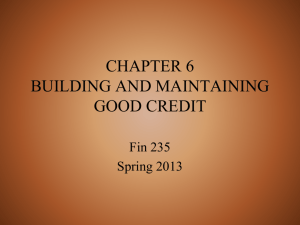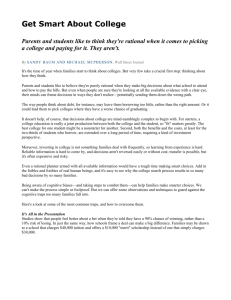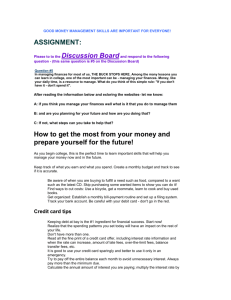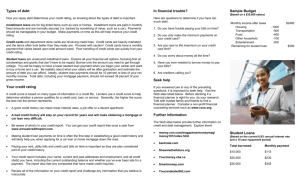1. Stop Increasing Your Debt
advertisement
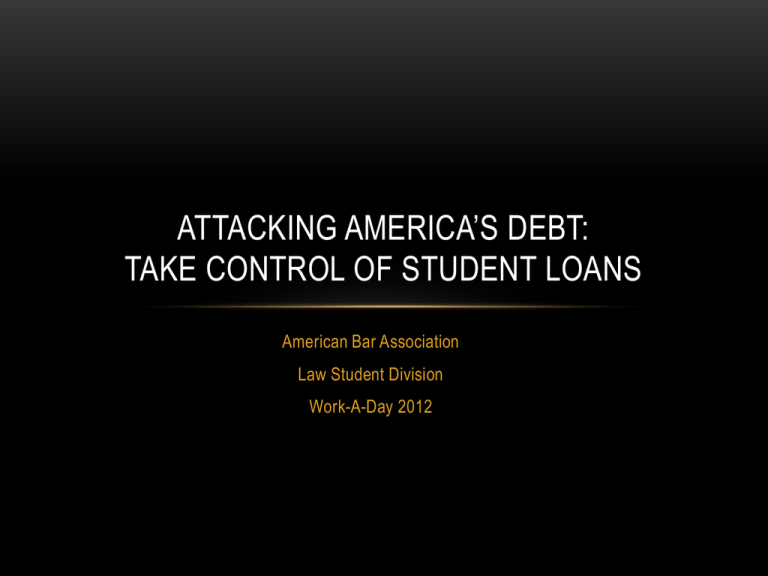
ATTACKING AMERICA’S DEBT: TAKE CONTROL OF STUDENT LOANS American Bar Association Law Student Division Work-A-Day 2012 WHAT ARE YOUR TOP STUDENT LOAN FINANCIAL CONCERNS? 1. 2. 3. STUDENT DEBT: WHY IS THIS A PROBLEM? • Why is this a problem? In today’s economy students who go to university and beyond are facing more debt than ever before with fewer job prospects. This toolkit is meant to give law students the information to help other students learn about the debt that they are taking on and how to handle it after they get out of school. This is an extremely timely topic that students are facing and the Committee and the Law Student Division are committed to helping students deal with their debt. THE COST OF COFFEE: A STUDENT LOAN PERSPECTIVE • What does that cup of coffee actually cost you? • Study time with 2-3 cups of coffee at Starbucks over 4 years can cost you as much as $4500 in just PRINCIPLE, INTEREST, AND FEES. DID YOU KNOW? • The nation’s national student loan debt is GREATER than the nation’s credit card debt. • The average outstanding balance on graduate student credit cards is $8,612, an increase of 10% from the 2003 average of $7,831. • Of students in both a professional or graduate program 56.4 percent of students are borrowing with a cumulative debt of $40,297. • Of those who are in law school 88.6% are borrowing money to pay for school compared to 55.2% of graduate school. • The average cumulative debt is $80,081 compared to $31,031 of those in graduate school. BREAKING DOWN THE FACTS: UNSUBSIDIZED LOANS • Federal government loans that are not based on financial need • Dependent of Independent Student • Maximum Amount of loan based on student status • Public Service • Income Based • Volunteer • Budget Resources • 10 Tips on Repayment • Online Resources BREAKING DOWN THE FACTS: GRADPLUS LOANS • Unsubsidized Loans • GradPLUS Loans • Public Service • Income Based • Volunteer • Budget Resources • 10 Tips on Repayment • Online Resources MAKING THE MOST OUT OF RESOURCES: BUDGETING • Budget Resources • 10 Tips on Repayment • Online Resources REPAYMENT OPTIONS: PUBLIC SERVICE LOAN FORGIVENESS • How it works? • Make 120 qualifying loan payments on eligible Federal Direct loans while working full-time in a qualifying public service program AND • The federal government will forgive the balance remaining on those Federal Direct Loans • While the debt is forgiven, it is counted as income for that year • Three Steps to earning PSLF • Must have eligible loans • Full Time Work in Qualifying Employment • Make 120 qualifying payments on those eligible loans while in the qualifying employment REPAYMENT OPTIONS: INCOME BASED REPAYMENT • Monthly payments are calculated based on income, rather than the amount owed • Qualification • Annual amount due on all of a borrower’s eligible loans exceeds 15% of discretionary income • Loans • Only federal loans apply (no commercial or private loans) • Bonus • If you have a partial financial hardship and are allowed to enroll in the Income-Based Repayment program, you may also qualify for the PSLF program after making 120 payments REPAYMENT OPTIONS: VOLUNTEER • AmeriCorps • Serve 12 months and receive up to $7400 in stipends plus $4725 to be used towards loans • Peace Corps • Volunteers can ask for deferment and partial cancellation of Perkins Loans • Volunteers in Service to America (VISTA) • Receive $4725 after completion of 1200 hours of service 10 TIPS ON DEBT REPAYMENT • 1. Stop Increasing Your Debt • Eliminate all excess credit cards. Keep one for use only in emergency situations. • 2. Record Your Spending • Keep a log or use an online tool so you can see how you are spending money. • 3. Categorize Your Spending • Must Haves – Living necessities such as food, rent, insurance • (Debt payments are a “must have” – pay more than the minimum required) • Should Haves – Things you need, but can do without for awhile (new clothes, gym membership) • Like to Have – Things you do not need, but enhance your life style (cable TV, coffee shops, additional functions on your phone) 10 TIPS ON DEBT REPAYMENT • 4. Make a Budget Based on Your Spending Record • Write down the amount spent in each category; make your budget reasonable • 5. Determine Your Debt Fund Amount • Based on your new budget, there will be areas of spending which can be cut back to provide extra money to put towards your debt • Be realistic and come up with budget amounts that enable you to live • 6. Determine how much you owe, to whom, and on what terms • Create a spreadsheet including the name of the creditor, your total balance, your minimum monthly payments, and your interest rate • Prioritize the debt – high interest rates or past due debt is a priority 10 TIPS ON DEBT REPAYMENT • 7. Pay it Off • Apply your budgeted debt fund to your debts – the “extra” money should go towards the debt with the highest priorities • 8. Continue With the Process Until You Eliminate Your Debt • • Cancel convenience credit cards (gas, store cards) after paying them off 9. Don’t Give Up! • It took awhile for the debt to accumulate; it will take time to pay it down • 10. Additional Resources • Resources include Debtors Anonymous and Credit Counseling BENEFITS OF USING CASH WHEN REDUCING DEBT • Using cash will make you feel as though your are spending more money than when using plastic • You can avoid financial mistakes and bank fees based on overdrawn accounts • Make major purchases with cash that you have saved • Only finance items that are absolutely necessary ADDITIONAL RESOURCES • Online Resources • Equaljusticeworks.org • Studentloans.gov • http://www2.ed.gov/offices/OSFAP/DirectLoan/calc.html - Loan Calculator and Budget tool • Finaid.org/loans
